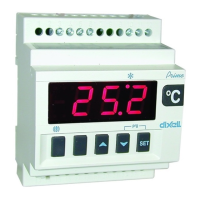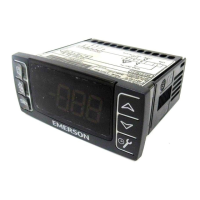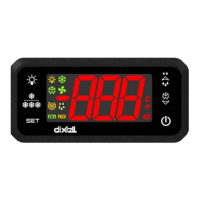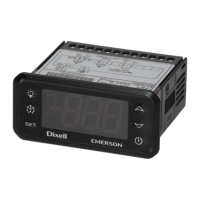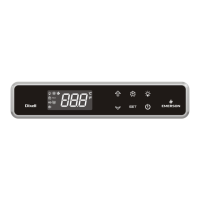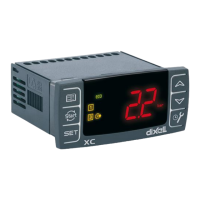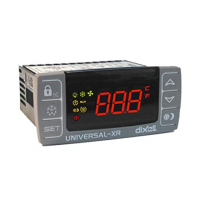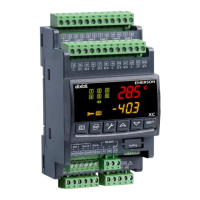1592023220 XM660K_XM670K GB r5.4 2021.09.01 XM660K - XM670K 6/9
FAN
FAP Fan probe: (nP; P1; P2, P3, P4, P5) first probe used for fan.
FnC Fan operating mode: C-n = running with the solenoid valve, OFF during the defrost; C-y =
running with the solenoid valve, ON during the defrost; O-n = continuous mode, OFF during the
defrost; O-y = continuous mode, ON during the defrost;
Fnd Fan delay after defrost: (0÷255 min) The time interval between the defrost end and evaporator
fans start.
FCt Temperature differential avoiding short cycles of fans (0.0°C ÷ 50.0°C; 0°F ÷ 90°F) If the
difference of temperature between the evaporator and the room probes is more than the value of
the Fct parameter, the fans are switched on;
FSt Fan stop temperature: (-50÷110°C; -58÷230°F) setting of temperature, detected by evaporator
probe, above which the fan is always OFF.
FHy Differential to restart fan: (0.1°C ÷ 25.5°C) (1°F ÷ 45°F) when stopped, fan restarts when fan
probe reaches FSt-FHy temperature;
tFE Fan regulation by temperature during defrost (n, y)
Fod Fan activation time after defrost: (0 ÷ 255 min.) it forces fan activation for indicated time;
Fon Fan ON time: (0÷15 min) with Fnc = C_n or C_y, (fan activated in parallel with compressor). it
sets the evaporator fan ON cycling time when the compressor is off. With Fon =0 and FoF ≠ 0
the fan are always off, with Fon=0 and FoF =0 the fan are always off.
FoF Fan OFF time: (0÷15 min) with Fnc = C_n or C_y, (fan activated in parallel with compressor). it
sets the evaporator fan off cycling time when the compressor is off. With Fon =0 and FoF ≠ 0 the
fan are always off, with Fon=0 and FoF =0 the fan are always off.
MODULATING OUTPUT - if present
trA Kind of regulation with PWM output: (UAL – rEG – AC) it selects the functioning for the PWM
output. UAL= the output is at FSA value; rEG= the output is regulated with fan algorithm
described in fan section; AC= anti-sweat heaters control (require the XWEB5000 system);
SOA Fixed value for analog output: (0 ÷ 100%) value for the output if trA=UAL;
SdP Default value for Dew point: (-55,0÷50,0°C; -67÷122°F) default value of dew point used when
there is no supervising system (XWEB5000). Used only when trA=AC;
ASr Dew-point offset (trA=AC) / Differential for modulating fan regulation (trA=rEG): (-25.5°C ÷
25.5°C) (-45°F ÷ 45°F);
PbA Differential for anti-sweat heaters: (0.1°C ÷ 25.5°C) (1°F ÷ 45°F)
AMi Minimum value for analog output: (0÷AMA)
AMA Maximum value for analog output: (Ami ÷ 100)
AMt Anti-sweat heaters cycle period (trA=AC)/ Time with fan at maximum speed (trA=rEG):
(0÷255 s) when the fan starts, during this time the fan is at maximum speed;
ALARMS
rAL Probe for temperature alarm: (nP - P1 - P2 - P3 - P4 - P5 – tEr) it selects the probe used to
signal alarm temperature
ALC Temperature alarm configuration: rE = High and Low alarms related to Set Point; Ab = High
and low alarms related to the absolute temperature.
ALU High temperature alarm setting: (ALC= rE, 0
50°C or 90°F / ALC= Ab, ALL
150°C or 302°F)
when this temperature is reached and after the ALd delay time the HA alarm is enabled.
ALL Low temperature alarm setting: (ALC = rE , 0
50 °C or 90°F / ALC = Ab , - 55°C or - 67°F
ALU) when this temperature is reached and after the ALd delay time, the LA alarm is enabled.
AHy Differential for temperature alarm: (0.1°C ÷ 25.5°C / 1°F ÷ 45°F) Intervention differential for
recovery of temperature alarm;
ALd Temperature alarm delay: (0÷255 min) time interval between the detection of an alarm condition
and the corresponding alarm signalling.
rA2 Probe for second temperature alarm: (nP - P1 - P2 - P3 - P4 - P5 – tEr) it selects the probe
used to signal alarm temperature
A2U Second high temperature alarm setting: (A2L
150°C or 302°F) when this temperature is
reached and after the A2d delay time the HA2 alarm is signalled.
A2L Second Low temperature alarm setting: (- 55°C or - 67°F
A2U) when this temperature is
reached and after the A2d delay time, the LA2 alarm is signalled.
A2H Differential for second temperature alarm: (0.1°C ÷ 25.5°C / 1°F ÷ 45°F) Intervention
differential for recovery of second temperature alarm;
A2d Second temperature alarm delay: (0÷255 min) time interval between the detection of second
temperature alarm condition and the corresponding alarm signalling.
dAO Delay of temperature alarm at start-up: (0min÷23h 50min) time interval between the detection
of the temperature alarm condition after the instrument power on and the alarm signalling.
EdA Alarm delay at the end of defrost: (0
255 min) Time interval between the detection of the
temperature alarm condition at the end of defrost and the alarm signalling.
dot Temperature alarm exclusion after door open: (0 ÷ 255 (min.)
tbA Disabling alarm relay by pressing a key: (n; Y)
OPTIONAL OUTPUT (only for XM670K)
oA5 relay at term. 1-2-3 configuration: (nP – CPr -CP2- -dEF-Fan-ALr-LiG-AUS-Htr-OnF - AC):
nP = not used; CPr= relay works as a compressor or solenoid valve relay; CP2= relay works as
second dEF= relay works as defrost relay; Fan= relay works as a Fan relay; ALr= activation with
alarm conditions; LiG= light activation; AUS= auxiliary relay, it can be switched ON/OFF also by
key; Htr = dead band regulation (not compatible with CrE=y); OnF= ON/OFF functioning, AC
= anti sweat heaters
oA6 relay at term. 17-18 configuration: nP – CPr -CP2- -dEF-Fan-ALr-LiG-AUS-Htr-OnF - AC):
nP = not used; CPr= relay works as a compressor or solenoid valve relay; CP2= relay works as
second dEF= relay works as defrost relay; Fan= relay works as a Fan relay; ALr= activation with
alarm conditions; LiG= light activation; AUS= auxiliary relay, it can be switched ON/OFF also by
key; Htr = dead band regulation (not compatible with CrE=y); OnF= ON/OFF functioning, AC
= anti sweat heaters
CoM Type of functioning modulating output:
• For models with PWM / O.C. output → PM5= PWM 50Hz; PM6= PWM 60Hz;
OA7= not set it;
• For models with 4÷20mA / 0÷10V output → Cur= 4÷20mA current output; tEn=
0÷10V voltage output;
AOP Alarm relay polarity: cL= normally closed; oP= normally opened;
iAU Auxiliary output is unrelated to ON/OFF device status: n= if the instrument is switched off
also the auxiliary output is switched off; Y= the auxiliary output state is unrelated to the ON/OFF
device status
DIGITAL INPUTS
i1P Digital input 1 polarity: (cL – oP) CL: the digital input is activated by closing the contact; OP:
the digital input is activated by opening the contact.
i1F Digital input 1 function: (nu - EAL – bAL – PAL – dor – dEF – AUS – LiG – OnF – Htr – FHU –
ES – Hdy) nu = not used; EAL= external alarm; bAL= serious external alarm; PAL= pressure
switch activation; dor= door open; dEF= defrost activation; AUS= auxiliary activation; LiG= light
activation; OnF= switch on/off the instrument; FHU= not used; ES= activate energy saving; nt =
second map enabling; cLn = clean function dEn = defrost off, CP1 = compressor 1 safety, CP2
= compressor 2 safety;
d1d Time interval/delay for digital input alarm: (0
255 min.) Time interval to calculate the number
of the pressure switch activation when i1F=PAL. If I1F=EAL or bAL (external alarms), “d1d”
parameter defines the time delay between the detection and the successive signalling of the
alarm. If i1F=dor this is the delay to activate door open alarm
i2P Digital input 2 polarity: (cL – oP) CL : the digital input is activated by closing the contact; OP:
the digital input is activated by opening the contact.
i2F Digital input 2 function: (nu - EAL – bAL – PAL – dor – dEF – AUS – LiG – OnF – Htr – FHU –
ES – Hdy) nu = not used; EAL= external alarm; bAL= serious external alarm; PAL= pressure
switch activation; dor= door open; dEF= defrost activation; AUS= auxiliary activation; LiG= light
activation; OnF= switch on/off the instrument; FHU= not used; ES= activate energy saving; nt =
second map enabling; cLn = clean function dEn = defrost off, CP1 = compressor 1 safety, CP2
= compressor 2 safety;
d2d Time interval/delay for digital input alarm: (0
255 min.) Time interval to calculate the number
of the pressure switch activation when i2F=PAL. If I2F=EAL or bAL (external alarms), “d2d”
parameter defines the time delay between the detection and the successive signalling of the
alarm. If i2F=dor this is the delay to activate door open alarm
i3P Digital input 3 polarity: (cL – oP) CL : the digital input is activated by closing the contact; OP:
the digital input is activated by opening the contact.
i3F Digital input 3 function: (nu - EAL – bAL – PAL – dor – dEF – AUS – LiG – OnF – Htr – FHU –
ES – Hdy) nu = not used; EAL= external alarm; bAL= serious external alarm; PAL= pressure
switch activation; dor= door open; dEF= defrost activation; AUS= auxiliary activation; LiG= light
activation; OnF= switch on/off the instrument; FHU= not used; ES= activate energy saving; nt =
second map enabling; cLn = clean function dEn = defrost off, CP1 = compressor 1 safety, CP2
= compressor 2 safety;
d3d Time interval/delay for digital input alarm: (0
255 min.) Time interval to calculate the number
of the pressure switch activation when i3F=PAL. If i3F=EAL or bAL (external alarms), “d3d”
parameter defines the time delay between the detection and the successive signalling of the
alarm. If i3F=dor this is the delay to activate door open alarm
nPS Pressure switch number: (0
15) Number of activation of the pressure switch, during the “d#d”
interval, before signalling the alarm event (I2F= PAL). If the nPS activation in the did time is
reached, switch off and on the instrument to restart normal regulation.
odc Compressor and fan status when open door: no = normal; Fan = Fan OFF; CPr =
Compressor OFF; F_C = Compressor and fan OFF.
rrd Outputs restart after doA alarm: no = outputs not affected by the doA alarm; yES = outputs
restart with the doA alarm.
RTC SUBMENU (if present)
CbP Clock Presence (n÷y): it permits to disable or enable the clock;
Hur Current hour (0 ÷ 23 h)
Min Current minute (0 ÷ 59min)
dAY Current day (Sun ÷ SAt)
Hd1 First weekly holiday (Sun ÷ nu) Set the first day of the week which follows the holiday times.
Hd2 Second weekly holiday (Sun ÷ nu) Set the second day of the week which follows the holiday
times.
Hd3 Third weekly holiday (Sun ÷ nu) Set the third day of the week which follows the holiday times.
ILE Energy Saving cycle start during workdays: (0 ÷ 23h 50 min.) During the Energy Saving cycle
the set point is increased by the value in HES so that the operation set point is SET + HES.
dLE Energy Saving cycle length during workdays: (0 ÷ 24h 00 min.) Sets the duration of the
Energy Saving cycle on workdays.
ISE Energy Saving cycle start on holidays. (0 ÷ 23h 50 min.)
dSE Energy Saving cycle length on holidays (0 ÷ 24h 00 min.)
Ld1÷Ld6 Workday defrost start (0 ÷ 23h 50 min.) These parameters set the beginning of the 6
programmable defrost cycles during workdays. Ex. When Ld2 = 12.4 the second defrost starts at
12.40 during workdays.
Sd1÷Sd6 Holiday defrost start (0 ÷ 23h 50 min.) These parameters set the beginning of the 6
programmable defrost cycles on holidays. Ex. When Sd2 = 3.4 the second defrost starts at 3.40
on holidays.
ENERGY SAVING
HES Temperature increase during the Energy Saving cycle : (-30÷30°C / -54÷54°F) sets the
increasing value of the set point during the Energy Saving cycle.
PEL Energy saving activation when light is switched off: (n÷Y)
n= function disabled;
Lig= energy saving is activated when the light is switched off and vice versa;
AUS= energy saving is activated when the AUX is switched off and vice versa;
LEA= energy saving is activated when the light & the AUX relays are switched off and vice versa;
LAN MANAGEMENT
LMd Desfrost synchronisation: y= the section send a command to start defrost to oher controllers,
n= the section don’t send a global defrost command
dEM Type of end defrost: n= the of the LAN defrost are indipendent; y= the end of the defrost are
synchronisated;
LSP L.A.N. set-point synchronisation: y= the section set-point, when modified, is updated to the
same value on all the other sections; n= the set-point value is modified only in the local section
LdS L.A.N. display synchronisation: y= the value displayed by the section is sent to all the other
sections; n= the set-point value is modified only in the local section
LOF L.A.N. On/Off synchronisation this parameter states if the On/Off command of the section will
act on all the other ones too: y= the On/Off command is sent to all the other sections; n= the
On/Off command acts only in the local section
LLi L.A.N. light synchronisation this parameter states if the light command of the section will act
on all the other ones too: y= the light command is sent to all the other sections; n= the light
command acts only in the local section
LAU L.A.N. AUX output synchronisation this parameter states if the AUX command of the section
will act on all the other ones too: y= the light command is sent to all the other sections; n= the
light command acts only in the local section
LES L.A.N. energy saving synchronisation this parameter states if the energy saving command of
the section will act on all the other ones too: y= the Energy Saving command is sent to all the
other sections; n= the Energy Saving command acts only in the local section
LSd Remote probe display: this parameter states if the section has to display the local probe value
or the value coming from another section: y= the displayed value is the one coming from another
section (which has parameter LdS = y); n= the displayed value is the local probe one.
LCP P4 probe sent via LAN (n, y)
StM Cooling activation via LAN: n= not used; Y= a generic cooling requests from LAN activate the
solenoid valve connected to compressor relay;
ACE Cooling by LAN always enabled even if the compressor block: (n, y)
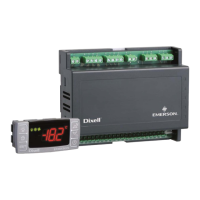
